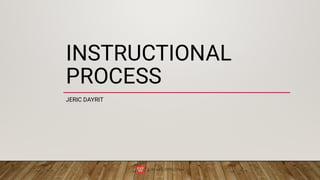
Instructional process
- 2. The Instructional Framework, identifies and illustrates the interrelationship among instructional process and approaches that, properly used, are acknowledged to be consistent with sound educational practice. The approaches are referenced to the goals of education and apply to the objectives of the various curricula.
- 3. A. INSTRUCTIONAL STRATEGIES • • Within each model several strategies can be used. Strategies determine the approach a teacher may take to achieve learning objectives. Strategies can be classed as direct, indirect, interactive, experiential, or independent. Although instructional strategies can be categorized, the distinctions are not always clear- cut. For example, a teacher may provide information through the lecture method (from the direct instruction strategy) while using an interpretive method to ask students to determine the significance of information that was presented (from the indirect instruction strategy).
- 5. • 1. Direct Instruction The Direct instruction strategy is highly teacher-directed and is among the most commonly used. This strategy includes methods such as lecture, didactic questioning, explicit teaching, practice and drill, and demonstrations. Direct instruction is usually deductive. That is, the rule or generalization is presented and then illustrated with examples. While this strategy may be considered among the easier to plan and to use, it is clear that effective direct instruction is often more complex than it would first appear.
- 6. • • • • • • • • Possible Methods Structured Overview (graphic organizer) Lecture Explicit Teaching Drill & Practice Compare & Contrast Didactic Questions Demonstrations Guided & Shared - reading, listening, viewing, thinking
- 7. • 2. Indirect Instruction Inquiry, induction, problem solving, decision making, and discovery are terms that are sometimes used interchangeably to describe indirect instruction. In contrast to the direct instruction strategy, indirect instruction is mainly student-centered, although the two strategies can complement each other. Examples of indirect instruction methods include reflective discussion, concept formation, concept attainment, close procedure, problem solving, and guided inquiry.
- 8. • • 2. Interactive instruction The interactive instruction strategy allows for a range of groupings and interactive methods. These may include total class discussions, small group discussions or projects, or student pairs or triads working on assignments together. It is important for the teacher to outline the topic, the amount of discussion time, the composition and size of the groups, and reporting or sharing techniques. Interactive instruction requires the refinement of observation, listening, interpersonal, and intervention skills and abilities by both teacher and students. The success of the interactive instruction strategy and its many methods is heavily dependent upon the expertise of the teacher in structuring and developing the dynamics of the group.
- 9. • • • • • • Possible Methods; Debates Role Playing Panels Brainstorming Peer Partner Learning Discussion • • • • • • • • • Laboratory Groups Think, Pair, Share Cooperative Learning Jigsaw Problem Solving Structured Controversy Tutorial Groups Interviewing Conferencing
- 10. • • • • • 3. Experiential learning can be viewed as a cycle consisting of five phases, all of which are necessary: experiencing (an activity occurs); sharing or publishing (reactions and observations are shared); analyzing or processing (patterns and dynamics are determined); inferring or generalizing (principles are derived); and, applying (plans are made to use learnings in new situations).
- 11. • • • • • • Possible Methods, Field trips Narratives Conducting experiments Simulations Games Story telling
- 12. • 4. Independent Study refers to the range of instructional methods which are purposefully provided to foster the development of individual student initiative, self-reliance, and self- improvement. While independent study may be initiated by student or teacher, the focus here will be on planned independent study by students under the guidance or supervision of a classroom teacher.
- 13. • • • • • • Possible methods; Essays Computer assisted instruction Journals learning logs Reports Homework Research projects
- 14. B. INSTRUCTIONAL METHODS • Methods are used by teachers to create learning environments and to specify the nature of the activity in which the teacher and learner will be involved during the lesson. While particular methods are often associated with certain strategies, some methods may be found within a variety of strategies.
- 16. C. INSTRUCTIONAL SKILLS • Skills are the most specific instructional behaviors. These include such techniques as questioning, discussing, direction-giving, explaining, and demonstrating. They also include such actions as planning, structuring, focusing, and managing.
- 17. • Explaining Some explanations are given to help students acquire or deepen their understanding of a concept, while others help students understand generalizations. Concerning the former, the teacher must select an appropriate concept definition and appropriate examples and nonexamples.
- 18. • Demonstrating Much student learning occurs through observing others. A demonstration provides the link between "knowing about" and "being able to do." Research reveals that demonstrations are most effective when they are accurate, when learners are able to see clearly and understand what is going on, and when brief explanations and discussion occur during the demonstration (Arenas, 1988).
- 19. • • • • • • • Questioning Among the instructional skills, questioning holds a place of prominence in many classrooms. When questioning is used well: a high degree of student participation occurs as questions are widely distributed; an appropriate mix of low and high level cognitive questions is used; student understanding is increased; student thinking is stimulated, directed, and extended; feedback and appropriate reinforcement occur; students' critical thinking abilities are honed; and, student creativity is fostered.
- 20. D. INSTRUCTIONAL MODELS • Models represent the broadest level of instructional practices and present a philosophical orientation to instruction. Models are used to select and to structure teaching strategies, methods, skills, and student activities for a particular instructional emphasis.
- 21. • • • • Four Instructional Design Models; Analysis, Design, Development, Inplemantation, Evaluation [ADDIE Model]. Merrill's Principles of Instruction. (Problem-based theory) Gagne's Nine Events of Instructions. Bloom's Taxonomy.
